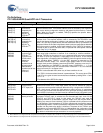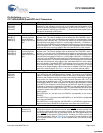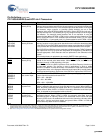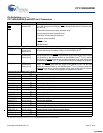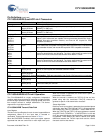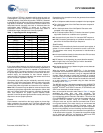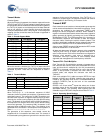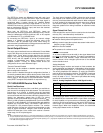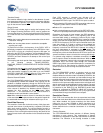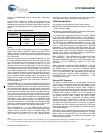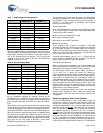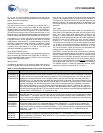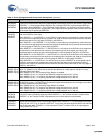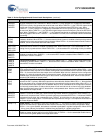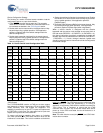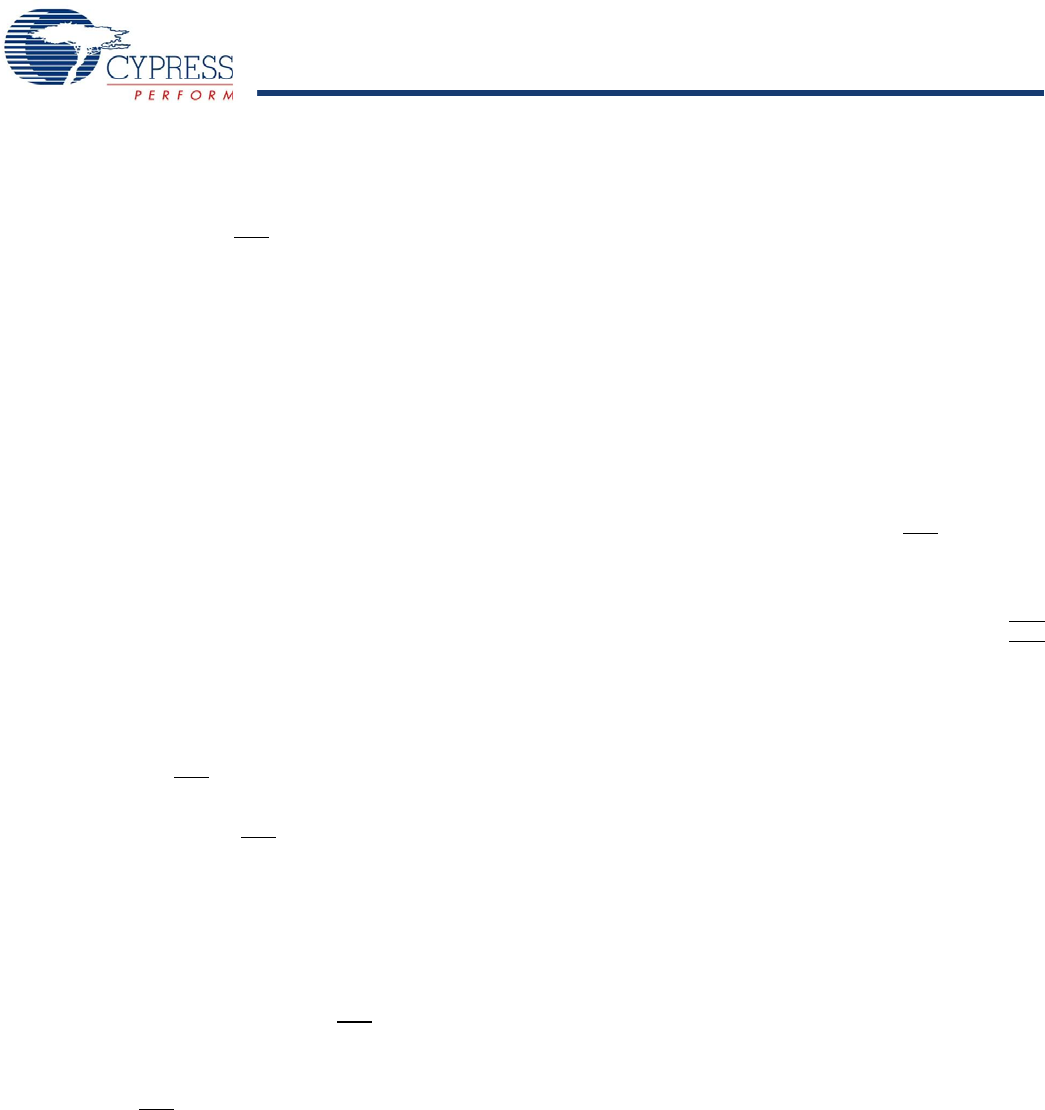
CYV15G0404DXB
Document #: 38-02097 Rev. *B Page 16 of 44
Transition Density
The transition detection logic checks for the absence of transi-
tions spanning greater than six transmission characters (60 bits).
If no transitions are present in the data received, the detection
logic for that channel asserts LFIx
.
Range Controls
The CDR circuit includes logic to monitor the frequency of the
PLL Voltage Controlled Oscillator (VCO) used to sample the
incoming data stream. This logic ensures that the VCO operates
at, or near the rate of the incoming data stream for two primary
cases:
■ When the incoming data stream resumes after a time in which
it has been “missing.”
■ When the incoming data stream is outside the acceptable
signaling rate range.
To perform this function, the frequency of the RXPLL VCO is
periodically compared to the frequency of the REFCLKx± input.
If the VCO is running at a frequency beyond ±1500 ppm, as
defined by the REFCLKx± frequency, it is periodically forced to
the correct frequency (as defined by REFCLKx±, SPDSELx, and
TXRATEx) and then released in an attempt to lock to the input
data stream.
The sampling and relock period of the range control is calculated
in the following manner: RANGE_CONTROL_
SAMPLING_PERIOD = (RECOVERED BYTE CLOCK PERIOD)
* (4096).
During the time that the range control forces the RXPLL VCO to
track REFCLKx±, the LFIx
output is asserted LOW. After a valid
serial data stream is applied, it may take up to one RANGE
CONTROL SAMPLING PERIOD before the PLL locks to the
input data stream, after which LFIx
should be HIGH.
Receive Channel Enabled
The CYV15G0404DXB contains four receive channels that can
be independently enabled and disabled. Each channel can be
enabled or disabled separately through the RXPLLPDx input
latch as controlled by the device configuration interface. When
the RXPLLPDx latch = 0, the associated PLL and analog circuitry
of the channel is disabled. Any disabled channel indicates a
constant link fault condition on the LFIx
output. When
RXPLLPDx = 1, the associated PLL and receive channel is
enabled to receive and decode a serial stream.
Note. When a disabled receive channel is reenabled, the status
of the associated LFIx
output and data on the parallel outputs for
the associated channel may be indeterminate for up to 2 ms.
Clock/Data Recovery
The extraction of a bit-rate clock and recovery of bits from each
received serial stream is performed by a separate CDR block
within each receive channel. The clock extraction function is
performed by an integrated PLL that tracks the frequency of the
transitions in the incoming bit stream and align the phase of the
internal bit rate clock to the transitions in the selected serial data
stream.
Each CDR accepts a character rate (bit-rate
÷ 10) or
half-character rate (bit-rate
÷ 20) reference clock from the
associated REFCLKx± input. This REFCLKx± input is used to
■ Ensure that the VCO (within the CDR) is operating at the correct
frequency (rather than a harmonic of the bit-rate)
■ Reduce PLL acquisition time
■ Limit unlocked frequency excursions of the CDR VCO when
there is no input data present at the selected serial line receiver.
Regardless of the type of signal present, the CDR attempts to
recover a data stream from it. If the signalling rate of the
recovered data stream is outside the limits set by the range
control monitors, the CDR tracks REFCLKx± instead of the data
stream. Once the CDR output (RXCLK±) frequency returns close
to REFCLKx± frequency, the CDR input is switched back to the
input data stream. If no data is present at the selected line
receiver, this switching behavior may result in brief RXCLK±
frequency excursions from REFCLKx±. However, the validity of
the input data stream is indicated by the LFIx
output. The
frequency of REFCLKx± is required to be within ±1500 ppm of
the frequency of the clock that drives the REFCLKx± input of the
remote transmitter to ensure a lock to the incoming data stream.
For systems using multiple or redundant connections, the LFIx
can be output to select an alternate data stream. When an LFIx
indication is detected, external logic can toggle selection of the
associated INx1± and INx2± input through the associated
INSELx input. When a port switch takes place, it is necessary for
the receive PLL for that channel to reacquire the new serial
stream and frame to the incoming character boundaries.
Reclocker
The CYV15G0404DXB contains a reclocker mode on each
receive channel that can be independently enabled and
disabled. When the reclocker mode is enabled by RCLKENx, the
received serial data is reclocked and transmitted through the
enabled differential serial outputs of the selected channel. In the
reclocker mode, the RXPLL performs clock and data recovery
functions on the input serial data stream and the reclocked serial
data is routed to the enabled differential serial outputs. The serial
data is also routed to the deserializer and the deserialized data
is presented to the RXDx[7:0] and RXSTA[2:0] parallel data
outputs as configured by DECBYPx. When the reclocker is
enabled, the data on the TXDx[7:0] and TXCT[1:0] is ignored and
not transmitted through the enabled serial outputs.
Deserializer/Framer
Each CDR circuit extracts bits from the associated serial data
stream and clocks these bits into the shifter/framer at the bit clock
rate. When enabled, the framer examines the data stream
looking for one or more COMMA or K28.5 characters at all
possible bit positions. The location of this character in the data
stream determines the character boundaries of all following
characters.
Framing Character
The CYV15G0404DXB allows selection of different framing
characters on each channel. Two combinations of framing
characters are supported to meet the requirements of different
interfaces. The selection of the framing character is made
[+] Feedback [+] Feedback



